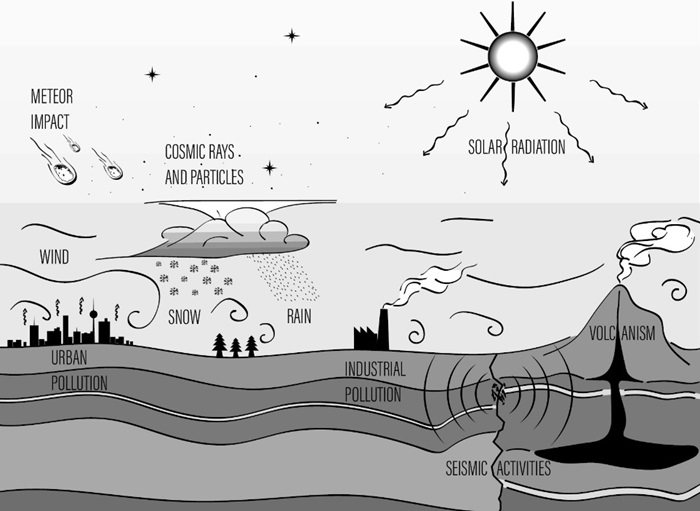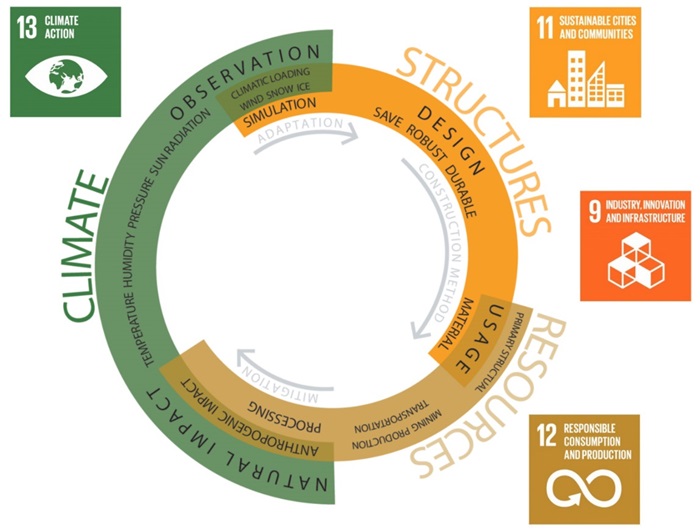Climate and Structures – A Concept of Interrelation
Throughout the history of humankind, structures were erected to create shelter from weather and environmental impacts, starting by using locally available materials. Structural geometry and concepts of the load carrying system were adapted and optimized through trial-and-error and systematic experimentation. Available resources were refined, material properties enhanced, and design methods improved, leading gradually to optimized structures within the associated ecosystem.
With the advent of globalization and industrialization, the supply chain for raw materials changed significantly and with that the advancement in architecture, design and structural performance. Construction materials, like concrete and steel, were produced from large-scale centralized industrial branches, affecting the environment by heavy resourcing of raw materials and changing its chemical state [1]. Such, not only standing in the direct interrelation with its local ecosystem, but rather affecting the biosphere and global climate, marking hence the era of the Anthropocene.


Figure 1: Aspects of climate-structures interrelation, including direct load impacts and long-term exposures of structures and humans within the built environment [1].
Figure 1 illustrates some of the main natural and anthropogenic elements in the ecology of natural environment, climate, structures and humans in the built environment. Structures are designed to withstand the impact from natural forces such as wind, snow, ice and earthquakes and are subjected to deterioration by climate impact like temperature, humidity and solar radiation. The climate in turn is affected by the manufacturing process of structures, e.g. through the herewith connected particle- and greenhouse gas emission, and through the expansion of urban land (e.g. surface albedo change). As described by the International Panel on Climate Change (IPCC), CO2-emissions are one of the key drivers in climate change [3], for which the construction sector plays a major role [2],[4],[5] - Cement production alone is responsible for around 4% of the world’s fossil fuel emissions [6]. The material use in structural building components has therefore a direct influence on the climate and the change of its physical state. The drivers of climate change derive from anthropogenic sources of aerosols and greenhouse gases like other fossil fuel consuming industries and of natural origin like volcanism, solar radiation flux, impacts from cosmic rays and particles [7] or even extraterrestrial objects, etc. [3] some of which are still under discussion (Figure 1). Other natural- but not climate related boundary conditions include soil and seismic activities. These conditions influence the choice for material, manufacturing technology, design of structural components and transportation and consequently the extent of associated emissions. Figure 2 illustrates the circular dependency of climatic boundary conditions, choice of resources and building technology, associated impact on environment and climate.
Ecological Structures
Centralization of material resourcing and the establishment of ubiquitous architectural and engineering standards are increasing the construction industry’s economical efficiency and safety. Construction materials are produced by large-scale industry branches and transported to construction sites, making it simple to apply proven and time-efficient structural designs. However, the same set of designs is used for all types of geographical highly diverse regions, giving less priority to the exploitation of local raw materials and customized designs. In this respect, current building practice has a significant impact on climate and environment caused by unnecessary greenhouse gas emission, resource consumption [4], and waste production.
As part of the UN-Sustainable Development goals [8], expressed by the EU-Commission [9] and the IPCC [2], sustainable solutions for mitigating climate change are needed. Therefore, awareness of an overuse of resources is also increasing in the construction sector, causing a call for more efficient technologies [10]. Recent advancements towards digitalization and automation could enable a high degree of structural customization for local climatic loading and resource availability. Technologies, such as advanced load simulation techniques, structural optimization methods, free form construction techniques, and novel material alternatives could increase the effectiveness of the industry [4] in terms of its ecological mutualism by rendering safe structures with minimal use of local materials.


Figure 2: Illustration of circular dependency of climatic boundary conditions, resulting climatic loading, choice of resources and building technology, and the associated impact on environment and climate (based on graphic in [1]).
The central strategy of the research group ‘Climate&Structures’ is to contribute to sustainable advancements in the technological aspects of the circular interdependency between climate and structures. To this end, the research work focuses on three main areas: 1) observation and simulation of loading processes (physical states of the climate action), 2) response, deterioration and adaptation of structural designs to climate and environmental loads, and 3) advancement of material science and construction methods to render ecological structures with optimized performance.